Qualcomm's Quad-Core Snapdragon S4 (APQ8064/Adreno 320) Performance Preview
by Anand Lal Shimpi & Brian Klug on July 24, 2012 7:10 PM EST- Posted in
- Smartphones
- Snapdragon
- Qualcomm
- Mobile
- Tablets
- APQ8064
- SoCs
- S4
If you've been following our SoC related coverage, you'll probably have come across our coverage of Qualcomm's upcoming SoCs in their Mobile Development Platforms (MDPs). It's an interesting way to get both a feeling for the performance of a given platform before things are final, and to see how much OEMs affect the final performance.
Qualcomm flew us out to San Francisco to take a look at its newest part, APQ8064, which is quad core Krait v2 at up to 1.5 GHz with Qualcomm's new Adreno 320 GPU, and no baseband. This is a SoC destined primarily for tablets, although the combination of APQ8064 and MDM9615 will likely also be a common upcoming platform for the highest end phones.
At present, this is the same Krait CPU as what we've seen in MSM8960 in phones like the USA versions of the Galaxy S 3 and HTC One X. Later on, Krait v3 will emerge with higher IPC and shorter critical paths (and clocks up to 1.7 or 2 GHz) and a resulting 10-15% boost in performance. For now however we're looking at 1.5 GHz APQ8064 with a Krait v2 inside and Qualcomm's newest scalar GPU architecture with Adreno 320. We're going to talk more about Adreno 320 closer to devices shipping, when Qualcomm feels comfortable talking architecture.
Probably the single biggest notable change is the option in Adreno 320 to change from a TBR (Tile Based Renderer) to an immediate mode renderer on the fly. By default, the render mode is still TBR, however an API is exposed to allow applications to request immediate mode. In the future, some heuristics will be used to determine which mode is faster, including rendering some frames in immediate mode, some frames in TBR mode. Initial shipping devices with Adreno 320 will however just expose an API until the switching system is finalized. Update: Adreno is still a TBR not TBDR as stated earlier.
In terms of features, Adreno 320 adds OpenGL ES 3.0 (codename Halti) support, and GPGPU capabilities with OpenCL 1.2 and RenderScript. In terms of Windows APIs, Adreno 320 is Direct3D 11 feature level 9_3.
After a morning of sessions about benchmarks and how they reflect different areas of performance (which is another big discussion), we were given hands on time with the mobile development platform for APQ8064, the MDP/T APQ8064. MDP for Mobile Development Platform, T for Tablet. The MDP/T includes a 10.1" WXGA display (1366 x 720), 2 GB of LPDDR2 at 533 MHz (2x32 bits, PoP), 13 MP rear camera, 7 microphones, and all the usual ports and buttons. The tablet was running Android 4.0.4, and although the software is understandably not final, things were pretty stable. In addition, the MDP/T will be sold though Bsquare at some later date for $1299.
Performance
Before we get too far in our performance testing, a refresher of the usual caveats is a good idea. We were allowed unsupervised benchmarking time with the APQ8064 MDP/T, however this is still a reference platform. Final shipping devices may run at different speeds or deliver different performance based on their software configuration. While the MSM8960 MDP ended up performing very close to HTC's One X/S, anything can happen in the final implementation of an SoC.
We'll start our performance analysis with GLBenchmark, more specifically, some of the raw feature tests to see just how things have improved over the MSM8960:
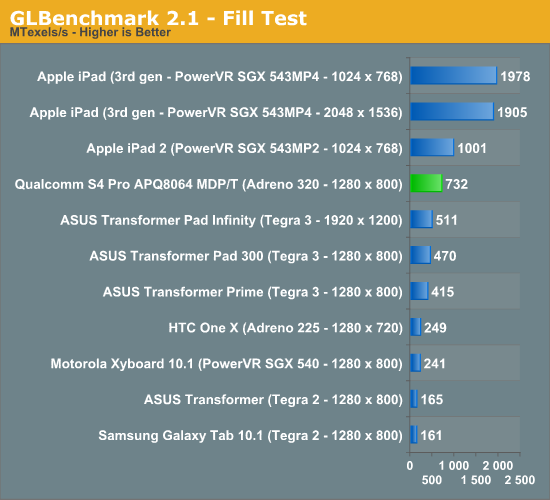
Raw fill rate almost tripled over the Adreno 225 in the HTC One X, and there's a healthy advantage over NVIDIA's Tegra 3 as well. Imagination's PowerVR SGX 543MP2 still manages a higher fill rate, and the MP4 in the new iPad can't be touched either.
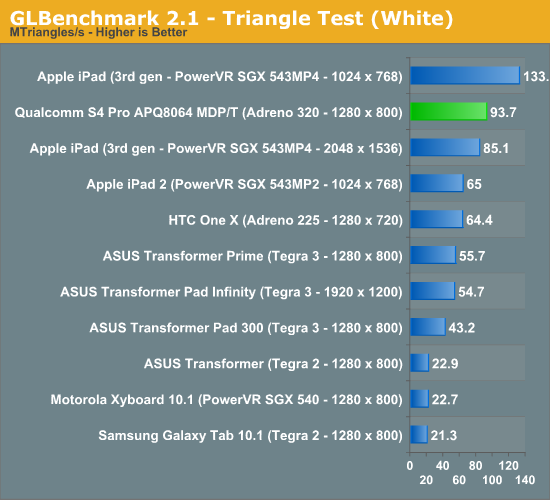
Raw polygon throughput is higher than everything aside from the 543MP4, an impressive step forward from the Adreno 225 but still not enough to outpace the high end ImgTec solution.
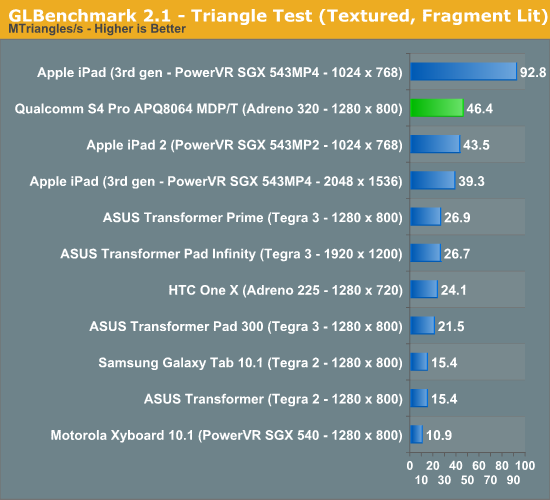
Here we see nearly 2x the triangle throughput of the Adreno 225, and better performance than the 543MP2. The MP4 continues to be a monster though.
These next two tests are rather meaningless as they're bound by vsync. Hopefully we'll see a newer version of GLBenchmark soon enough that will stress these devices more at native resolutions:
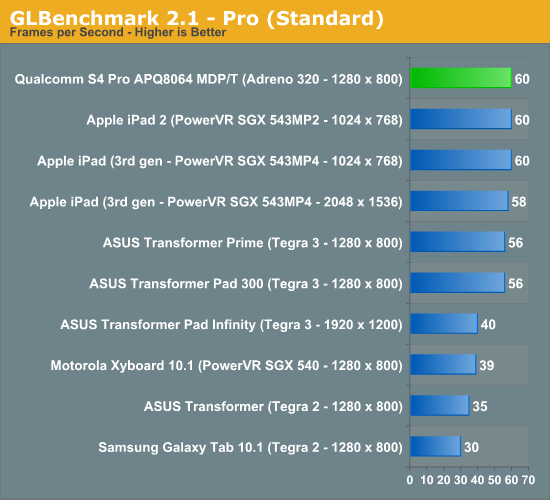
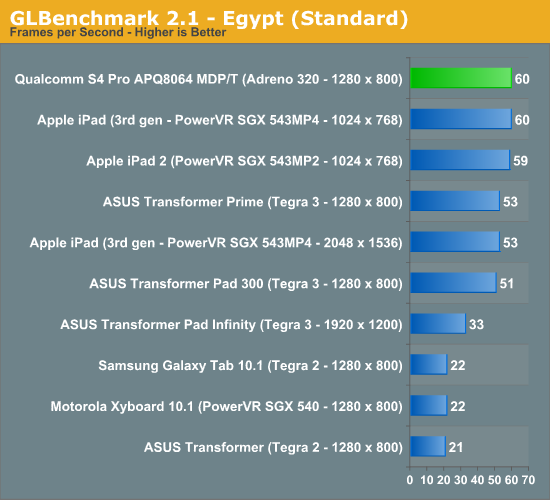
GLBenchmark gets around the default vsync requirement by rendering to an offscreen buffer at 720p, giving us a true apples-to-apples comparison of game-like performance among all of these SoCs. The quad-core S4 Pro with Adreno 320 does incredibly well:
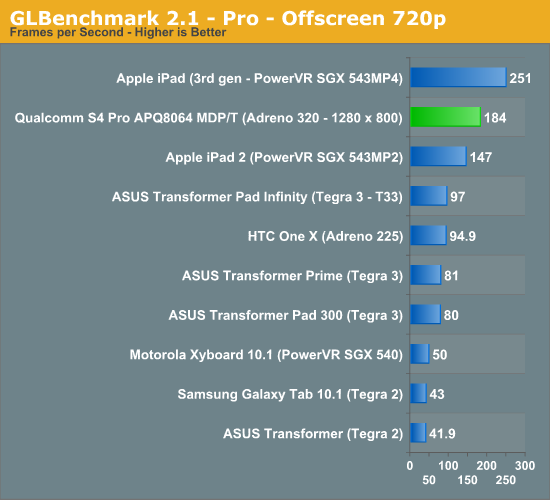
In the older Pro test frame rates are insanely high for most of the devices, indicating the age of the benchmark, but the Adreno 320's standings are very good - second to only the PowerVR SGX 543MP4. Compared to the Adreno 225, the 320 is almost twice as fast.
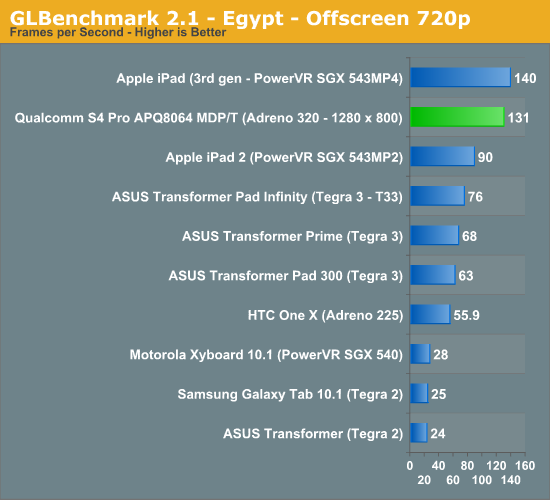
Egypt, the newer of the two "game" tests in GLBenchmark is a bit more stressful. Here the Adreno 320 gets extremely close to the SGX 543MP4 in the new iPad. Apple maintains a 6.8% performance advantage at 720p in this, a largely compute bound benchmark. Performance here is more than double that of the Adreno 225, and 72% faster than NVIDIA's fastest Tegra 3.
Overall Adreno 320 looks to be a good step forward in performance, although still a bit slower than the latest and greatest from Imagination Technologies. Compared to what everyone else is shipping in Android based tablets/smartphones however, Adreno 320 is easily the new king of the hill.
Qualcomm integrated four Krait v2 cores in the APQ8064 running at 1.5GHz, so CPU performance should range from very similar to significantly better than the dual-core Snapdragon S4 depending on the workload. Just as we've seen with Tegra 3, heavily threaded workloads will scale quite nicely while lightly threaded workloads will look mostly the same:

Sunspider performance is excellent on the MDP/T, actually delivering a better score than the Medfield based Lava Xolo X900 (1279.4ms). It's unclear how much of this performance increase over the dual-core S4 is due to the added cores vs. software optimizations to the MDP/T's browser.
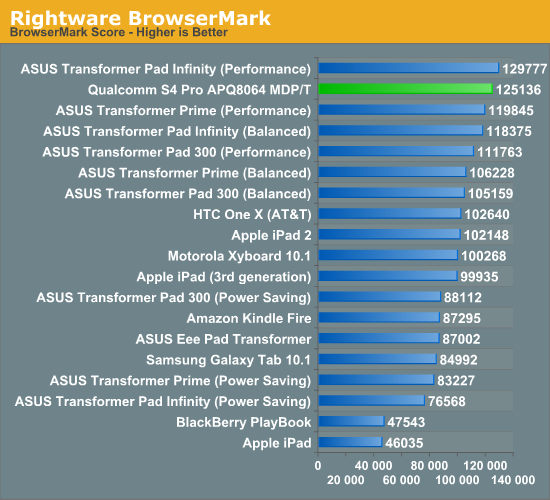
BrowserMark tells a much more conservative story, however the S4 Pro is still able to outpace the dual-core S4 based One X by 22%. Again we're doing a bit of apples-to-oranges here since the browser and remaining software stack between devices isn't perfectly identical.

Vellamo is Qualcomm's in-house developed web performance and scrolling benchmark, which soon will expand to include some more testing beyond JavaScript and scrolling performance (more on that later). For now, APQ8064 eeks out of the rest of the pack, but not by a huge margin. This again is using WebView which isn't heavily threaded.

BaseMark OS includes a heavily threaded benchmark that can hit all four cores in the MDP/T as well as in the Tegra 3 based devices. The overall score incoporates the SMP test but doesn't weight it too heavily. The end result is still good for the MDP/T; it's the fastest Android device we've tested here.
We ran the multithreaded Linpack Android test to confirm quad-core scaling and indeed we saw just that. While the HTC One X is good for a score of around 210 MFLOPS, the MDP/T with twice the cores hit 413 MFLOPS. We were able to get numbers as high as 514 MFLOPS, which is more a demonstration of the volatility of the test than anything else.
Overall the quad-core S4 Pro should deliver everything we love about the dual-core S4's performance, just with more cores. As individual cores can be power gated, there shouldn't be much of a power penalty unless you actually need the extra power. The extra cores should come in handy with heavy multitasking (something we may see even more of on Windows RT tablet/notebook hybrids) or with the rare heavily threaded application.


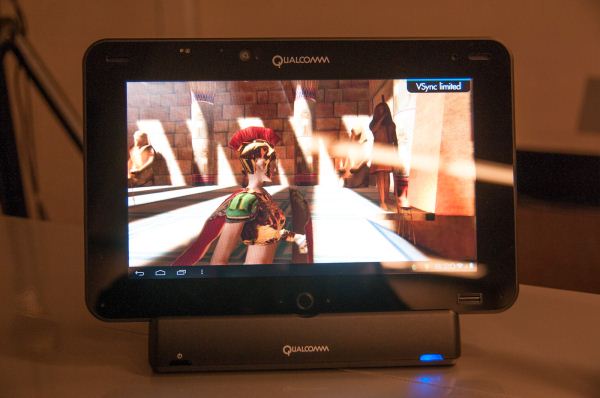






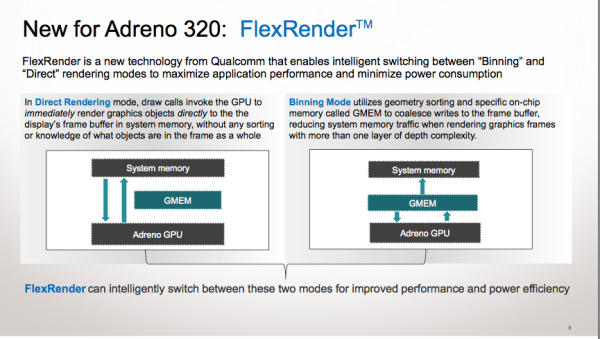














35 Comments
View All Comments
Ryan Smith - Wednesday, July 25, 2012 - link
Sorry, I misspelled that. It's Gravatar.comRocket321 - Wednesday, July 25, 2012 - link
I think your power conclusion is a bit misleading or at least should be clarified. In the case of a Tablet things are spot on. However you mentioned in the article this SoC may make its way into high-end phones coupled with a MDM chip to provide air interfaces. This would likely come at a significant power hit over currently shipping Krait phones which have the air interfaces integrated.maxsteve - Wednesday, July 25, 2012 - link
Dear Anand, I'm a avid reader of your website since long. But never felt like posting anything. As you cover almost everything in your reviews.But this morning I just felt like asking you for few things. Hope you'll consider it.
1. Looking for review on following.
Allwinner 10 Cortex A8 Mali400x2 Cost $4/1000 pcs
Amlogic Dualcore A9 MX3L Mali400x2 Cost 6$/1000pcs
RK3066 Dualcore A9 Mali400x4 Cost $9 /1000pcs
Freescale i.mx6 QUAD adreno320 Cost unknown
Huawei K3 QUAD Cost Unknown
MTK A9 6575 integrated cellular dualsim dual standby Cost 4$/1000
MTK Dualcore A9 6577 integrated cellular dual sim dual standby Cost $7 /1000
Telechips8925 A8 Cost $3 / 1000
Telechips 8965 A9 DualCore Cost $4 /1000
Upcoming by Christmas on real products:
MTK QUAD 6585 28nm Mali 543mp4
Allwinner A10II QUAD 32nm Mali450x4
Amlogic QUAD 32NM Mali450x4
Rockchip4066 QUAD 32 Mali543mp4
Huawei +1 series QUAD
ZTE unnamed QUAD
Point of enlisting all this: TIME HAS CHANGED.
Quality processors with cheap prices, Chinese are doing it well. So they also deserve some mainstream love from websites like this.
And I'm sure there are lot of out there who want to see the benchmarks of these el-cheapos give run for their money to these biggies.
2. Headers on Anandtech
_____________________________________________________________________________________________________
CPUs Motherboards SSD/HDD GPUs Mobile IT/Datacenter
_____________________________________________________________________________________________________
Smartphones Memory Cases/Cooling/PSU(s) Displays Mac Systems Linux Trade Shows Guides
_____________________________________________________________________________________________________
My apologies but again, Time bas changed. Now tablet is coming into mainstreams soon going to replace laptop of happy go crowds. (Not talking about you:))
My point of view is add a "Tablets" Header. Time of tablets has come, They have arrived. So please acknowledge it. Give them their place with due respect.
Also "Mobile" and "Smartphones" placement should be swapped. As its more easy on eyes and less confusing to see "Tablets" and "Smartphones" sitting besides each-other.
3. This is an extra complementary demand, Please add a "Processors" Header under which there is enlisting of processor as per their features and category. Can also be linked with their respective benchmarks etc.
I know I'm being too greedy, But trust me all your loyal readers are gready for more and more info. Its all your fault, You have spoiled them. :)
Apologies for the offtopic post.
Have a great day and good luck.
Max
barn25 - Wednesday, July 25, 2012 - link
Time and time again anand has shown a disdain for using real bench marks rather than what the maker provides. Its really sad actually because it is apparent that he is an all-round intelligent guy. Sites like xbit labs and realworld technologies as well as phoronix use benchmarks without bending backwards to intel or anybody.Arnulf - Friday, July 27, 2012 - link
This thing is finally suitable for non-x86 PCs that IT analystis are predicting to emerge en massse by 2015. Enough horsepower for all desktop work, internet browsing, multimedia and Ouya kind of games. Now if only VIA could get this onto their "VAB" board in place of those lame 800/1000 MHz chips and sell it at a reasonable price ...